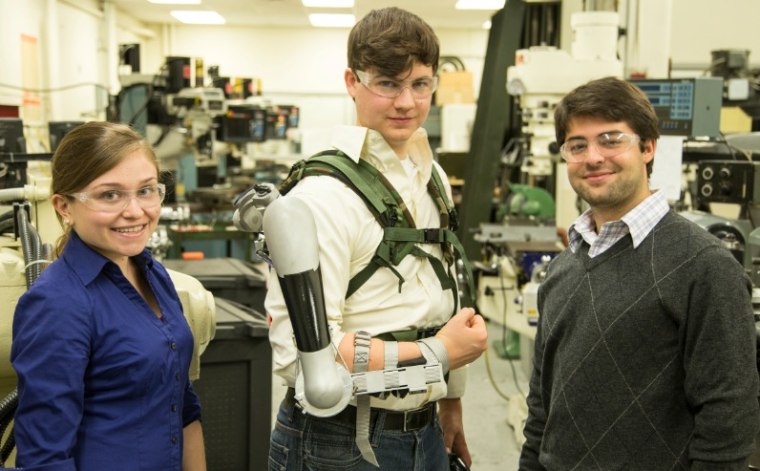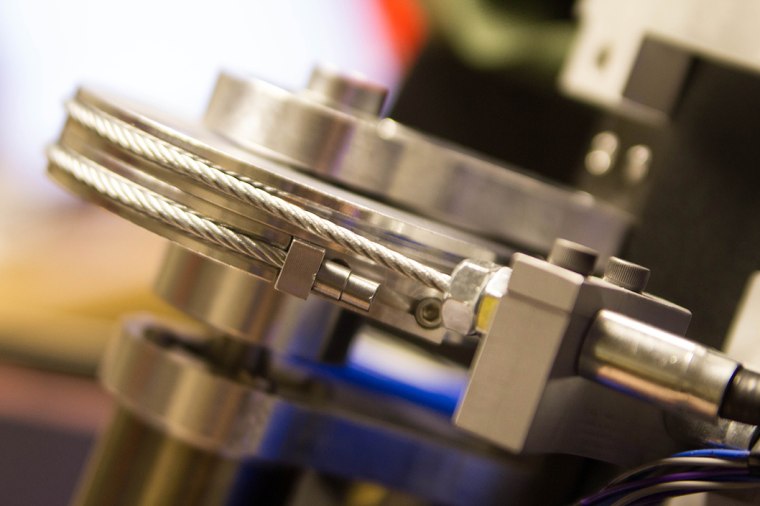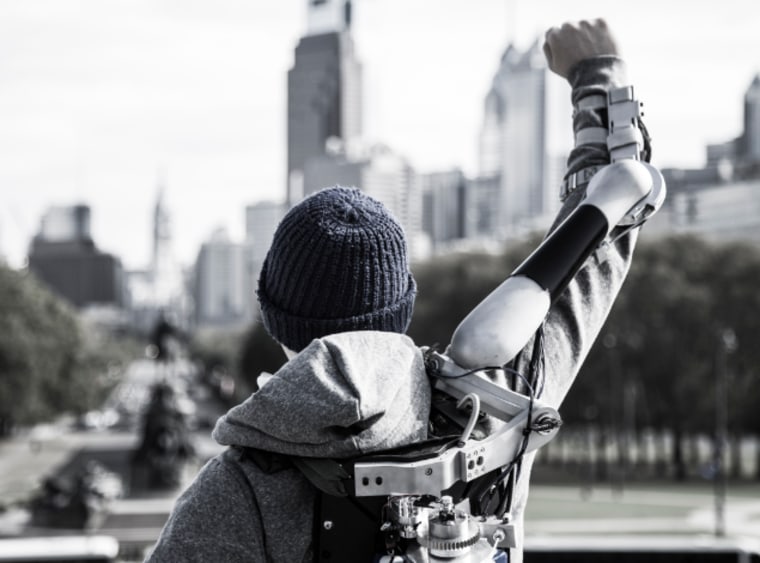From a field of extremely promising inventions by young designers and engineers, a winner has been chosen for the £30,000 James Dyson Award: the Titan Arm, a low-cost upper-body exoskeleton that can aid in both physical therapy and heavy lifting.
"The first, second and third place all had really clever ideas," Sir James Dyson told NBC News in a phone interview.
Dyson is head of the company bearing his name, most famous for the vacuum cleaners he designed — but the award, given since 2007 to student engineering and design teams aiming at solving a problem, is given through his philanthropic foundation.
Previous winners have included self-inflating motorcyclist jackets, smart fish nets, and a device for getting life rings to distant drowning victims. Among this years entries were a concussion-detecting mouthguard and a high-tech life vest. This year's first place choice, the Titan Arm, stood out for several reasons, according to Dyson.
"In general, empowering people to lift things at home or at work is a really helpful thing," he said. "And it's a very professional — and 'professional' is a strong word — well-done project."
The Titan Arm, designed by three students at the University of Pennsylvania, fits onto the back and arms of anyone who needs a little help manipulating objects — whether that's someone who works at UPS and is picking up packages all day, or someone with muscular dystrophy who has trouble lifting a glass of water.
There are other options out there, from the likes of Raytheon, but they cost upwards of $100,000. The Titan arm was vastly cheaper to research and build — around $2,000.

"This was developed on a student project budget," said Nick Parrotta, one of the engineers on the design team, in a phone interview with NBC News. And the team only had four members: Parrotta and Niko Vladimirov on mechanical design, Nick McGill on electronics, and Liz Beattie on power transmission.
Compared with the bulky, often externally powered systems out there today, the Titan Arm is extremely simple. The backpack holds the power source (two 5,000-mAh lithium batteries) and a motor that tightens or slackens a steel cable running through the arm piece. This cable, running through a few cleverly engineered joints, aids the user in picking up the object at hand. All together, the device weighs just 18.5 pounds.
This design mimics the way our own upper back and arm muscles work, something the Dyson Award judges did not fail to notice.
"To use the back correctly in order to lift things was a very clever principle," said Dyson. "And we like the fact that it potentially retrains muscles."

Indeed, though it is capable of aiding with loads up to 40 pounds, it can be configured to aid the user to whatever degree is necessary — or deemed proper by a therapist.
"In a physical therapy scenario, you don't need to lift nearly as much weight," explained Parrotta. Therapeutic versions of the Titan Arm could be lighter and have fewer parts, he said, and motion could be tied directly to your body movements rather than the hand-held controller used now.
"Something we're really excited about is electromyography: You apply patches to the user's skin and read the activity of the muscle, then you can pass that on to tell the arm what to do." Parrotta mentioned they're hoping to include support for the Myo armband, which detects such signals and relays them wirelessly to an iPhone app.
That such an advance came from a handful of engineering students and not a DARPA-funded robotics lab shouldn't be too much of a surprise, suggested Dyson.
"It's not a glamorous invention, but it's a hugely important one," he continued. "It takes an unfettered student to come up with these ideas. I rather like these unglamorous projects. In a way, you've got slightly more freedom, and they often have much more impact on the world and on our lives."
What's next for the Titan Arm team? "It's tricky, because we're all students who are either working or pursing graduate degrees," said Parrotta. "But winning the James Dyson award is going to encourage us to keep pursuing the project." With about $48,000 for the students themselves and $16,000 for their department, they'll be far better off money-wise than they were when they started.
Nor will they be short for inspiration, he concluded. "We've had a large outreach of potential users… they're really excited about using a device like ours to regain that range of motion. We find stories like that really, really motivating."
Devin Coldewey is a contributing writer for NBC News Digital. His personal website is coldewey.cc.
